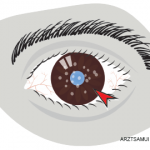At week 22, 81% of patients in the infliximab treatment group achieved complete response compared with 56% of those in the cyclophosphamide treatment group. Fewer adverse events were reported in patients who received infliximab than those who received cyclophosphamide (30% vs. 64%, respectively).5
In Dr. Piga’s view, this study clearly demonstrates that induction therapy with infliximab and glucocorticoids should be a first-line therapy in patients with organ- or life-threatening disease.
Other Promising Treatments
Additionally, Dr. Piga discussed other studies exploring treatment options for patients with Behçet’s disease.
A study from Moots et al. showed that in patients with active, refractory disease of all subtypes infliximab and interferon‑α2a demonstrated comparable efficacy and safety for inducing remission.6
A study from Zhong et al. showed that adalimumab plus corticosteroid treatment was superior to cyclosporine plus corticosteroids with respect to uveitis relapse rates in patients with severe Behçet’s disease who are naive to anti-tumor necrosis factor therapy.7
In a phase 3 study of 40 patients with active mucocutaneous lesions despite three or more months taking standard immunosuppressants, both infliximab and adalimumab were highly effective in inducing remission of the lesions and well-tolerated by patients. However, adalimumab demonstrated a significantly faster and higher response rate than infliximab.8
Finally, an observational study by Penuelas Leal et al. demonstrated that oral roflumilast—a phosphodiesterase-4 inhibitor often used in chronic obstructive pulmonary disease—had a potential benefit in reducing mucocutaneous and articular manifestations in patients with Behçet’s disease. However, the study authors note the agent remains investigational and is not established for severe, organ-threatening disease.9
Dr. Piga noted that upadacitinib is another medication that may show promise for the treatment of Behçet’s disease, but future studies into upadacitinib are needed.
Preventing Organ Damage
Throughout his talk, Dr. Piga repeated a key point: A window of opportunity to treat the inflammatory features of Behçet’s disease exists. If inflammation in the disease is not promptly identified and effectively intervened upon, then irreversible organ damage can ensue, causing long-term negative implications for patients.
Three main damage assessment tools are used for Behçet’s disease: the Vasculitis Damage Index (VDI), the Behçet’s Overall Damage Index (BODI) and the Behçet’s Disease Damage Index (BDI). Each tool is designed to assess irreversible organ damage, but they differ in scope, specificity and clinical utility. VDI is a generic tool developed for systemic vasculitides. Both BODI and BDI are specific to Behçet’s disease. According to Dr. Piga, BODI has the strongest evidence for validity and responsiveness in terms of assessing organ damage due to Behçet’s disease.


